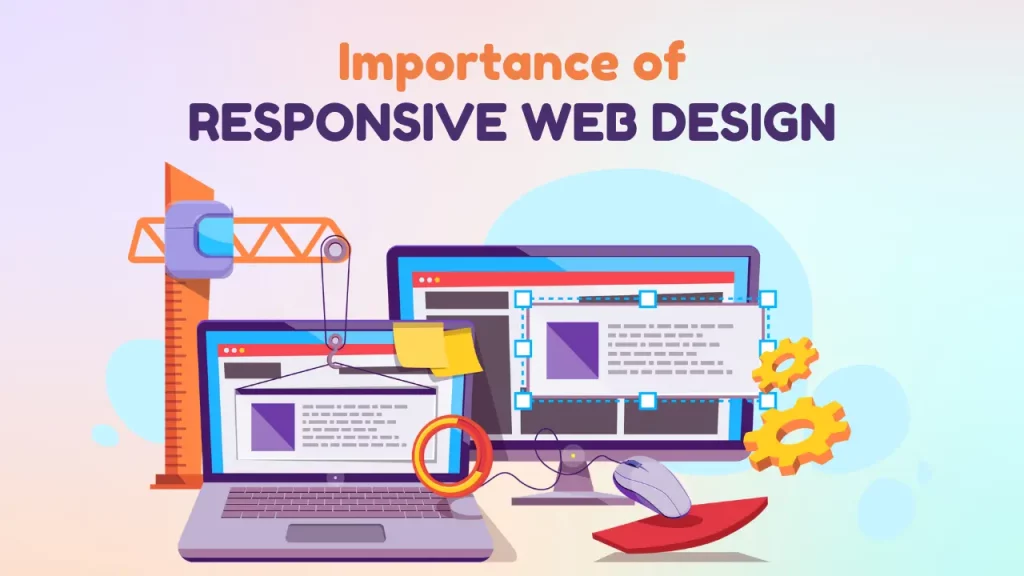post
The Importance of Responsive Web Design in 2023

Introduction to Responsive Web Design

In the dynamic world of 2023, responsive web design isn't just a buzzword; it's the cornerstone of digital user experience. This innovative design philosophy revolutionizes how we interact with websites, making them fluid and adaptable across a myriad of devices, from the sleek smartphone in your pocket to the expansive desktop screen in your office. With a staggering majority of users now accessing the web through mobile devices, responsive design has catapulted from a 'nice-to-have' to an absolute must-have for any digital presence.
This article isn't just a tour through the mechanics of responsive design; it's a deep dive into its essence. With companies like Naxotop leading the charge offering expert services in web development and design, your digital presence is guaranteed to be both dynamic and responsive, adapting effortlessly to user needs.
We're addressing not just web developers and tech gurus but also business owners and digital enthusiasts who recognize the pivotal role of responsive design in staying relevant in today's rapidly evolving digital ecosystem.
Understanding Responsive Web Design
Responsive web design is like a chameleon, seamlessly blending into the environment of various devices. Naxotop's mastery in web development and design shines here, as they employ these core components:
- Fluid Grids: These are the backbone of responsive design, using relative units like percentages to ensure elements on the page resize in harmony with the screen size.
- Flexible Images: Just like fluid grids, these images adapt and resize within their containers. It's all about ensuring visuals look sharp and fitting without awkward overflows or pixelation.
- Media Queries: These are the secret sauce in CSS3, enabling the application of different style rules for different devices. It's like having a personal stylist for your website, ensuring it always looks its best, no matter the device.
Responsive design marks a departure from the rigid, one-size-fits-all approach of traditional web design. It's a forward-thinking strategy, embracing the diversity of devices that colour our digital world.
The Rise of Mobile Internet Usage
Imagine a world where over half of all web traffic comes from mobile devices. Welcome to 2023, where this is our reality. This monumental shift has redefined not just web design but the entire spectrum of digital interaction and content consumption.
- Statistical Insights: Smartphones are more than communication devices; they're gateways to the digital world, preferred by users for their convenience and connectivity.
- User Behavior Patterns: The mobile user is all about speed and ease. Quick, snackable content and intuitive Navigation are paramount, setting the stage for web designs that cater to this fast-paced lifestyle.
- Impact on Business and Web Development: For businesses and developers, adapting to this mobile-first world isn't optional; it's critical. It's about crafting digital experiences that resonate deeply with mobile users. Naxotop specializes in creating digital experiences that resonate with mobile users, understanding their unique behaviors and preferences.
- Search Engine Adaptation: Google and other search engines have joined this mobile march, rewarding mobile-friendly websites with higher rankings. In the realm of SEO, responsive design is your golden ticket.
This shift isn't just a trend; it's a seismic change in how we interact digitally, placing responsive design at the heart of modern web development.
Benefits of Responsive Web Design
Responsive web design is more than a technical solution; it's a key to unlocking numerous benefits:
- Enhanced User Experience: It's all about delivering a smooth, consistent experience across devices, ensuring ease of Navigation and legibility.
- SEO Advantages: In the SEO arena, responsive design is a heavyweight champion. Search engines love mobile-friendly sites, and a responsive design is your site's best bet for climbing those rankings. As a leader in web design and development, Naxotop utilizes responsive design to help your site climb the SEO rankings.
- Cost-Effectiveness and Easy Maintenance: One site to rule them all! Managing a single responsive site is far more efficient than juggling multiple versions for different devices.
- Competitive Edge and Brand Perception: A responsive website isn't just about functionality; it's a powerful statement about your brand's commitment to innovation and user satisfaction.
In the fast-paced digital world of 2023, responsive web design is not just a trend but a strategic imperative for businesses aiming to thrive online.
Challenges in Implementing Responsive Design
Overcoming these challenges is critical to delivering a responsive website that not only looks great but also performs flawlessly. Naxotop's expertise in app development and web designing ensures a seamless transition to responsive design. Implementing responsive design, while beneficial, comes with its own set of challenges:
- Technical Complexities: Mastering the art of responsive design requires a deep understanding of HTML, CSS, JavaScript, and the principles of fluid grids, flexible images, and media queries.
- Balancing Aesthetics with Functionality: Finding the sweet spot between a visually appealing design and functional adaptability can be challenging, often requiring creative solutions to maintain usability.
- Maintaining Consistent User Experience: Delivering a uniform user experience across a variety of devices, each with different screen sizes and resolutions is a complex but essential task.
- Staying Updated with Evolving Technologies: Keeping pace with the rapid evolution of web technologies is crucial to ensure that responsive designs stay relevant and practical.
Overcoming these challenges is critical to delivering a responsive website that not only looks great but also performs flawlessly.
Responsive Design Best Practices
Embracing best practices in responsive design is crucial for its success:
- Start with a Mobile-First Approach: Begin by designing for the smallest screen, ensuring that the most vital content and functionalities are prioritized.
- Use Flexible Layouts and Images: Implement fluid grid layouts and scalable images to ensure smooth resizing and optimal display across different devices.
- Implement CSS Media Queries: Use media queries to apply distinct styles for different devices, adapting to various screen sizes and user needs.
- Prioritize Content and Simplify Navigation: Opt for streamlined content and Navigation tailored for mobile users, ensuring ease of access and engagement.
- Optimize Performance and Load Times: Focus on reducing file sizes and optimizing content delivery for rapid loading, a crucial factor for mobile users.
- Regular Testing and Updates: Continually test your website on diverse devices and browsers, and stay abreast of the latest web standards and technologies.
These best practices ensure that responsive design not only meets technical requirements but also delivers a superior user experience.
Case Studies in Responsive Web Design
These case studies showcase Naxotop's proficiency in implementing responsive design across various industries. Let's explore some real-life case studies that highlight the transformative impact of responsive web design:
1. E-Commerce Retailer: Fashion Forward
- Background: Struggled with declining sales and high mobile bounce rates.
- Challenge: A non-optimized website for mobile devices resulted in poor performance.
- Solution: Partnered with web design experts for a mobile-first, responsive redesign.
- Results: Witnessed a 40% decrease in bounce rates and a 35% increase in sales, with mobile transactions playing a pivotal role.
2. Healthcare Portal: MedAccess
- Background: Faced with low engagement and accessibility issues on mobile devices.
- Challenge: Overwhelming mobile user experience due to extensive content and complex structure.
- Solution: Revamped the site focusing on mobile-responsive design.
- Results: Achieved a 50% boost in mobile user engagement and improved session duration.
3. Local Restaurant Chain: BistroBox
- Background: Aimed to increase online orders and reservations via their website.
- Challenge: The existing non-mobile-friendly site deterred smartphone users.
- Solution: Updated to a responsive design, enhancing the online ordering and reservation experience.
- Results: Experienced a 60% increase in online activity, with positive feedback on improved usability.
These case studies demonstrate how responsive web design can address specific industry challenges, boosting digital presence and performance.
The Future of Responsive Design
As we look to the future, responsive web design is poised to embrace a range of emerging technologies and trends, reshaping how we interact with the digital world:
- Advanced Technologies: The integration of AI and machine learning will bring about more personalized and dynamic web experiences. Websites will adapt in real-time to user behaviours and preferences.
- Voice and Gesture-Based Navigation: With the rise of voice assistants and gesture-based interfaces, responsive design will expand beyond screen size adaptability to include new ways of interacting with content.
- Augmented and Virtual Reality (AR/VR): As AR and VR technologies mature, we can expect to see them blend seamlessly into responsive web design, offering immersive experiences, particularly in fields like e-commerce, education, and entertainment.
- Focus on User Experience (UX): Future responsive designs will prioritize creating engaging and intuitive user experiences, using micro-interactions and animations to enhance engagement.
- Accessibility and Inclusivity: A significant focus will be on making websites accessible to all, ensuring responsive design includes considerations for users with disabilities.
- Sustainability in Web Design: As global environmental concerns grow, sustainable web design practices will become increasingly important, focusing on energy-efficient coding and optimized content delivery.
As we embrace these advancements, responsive web design will continue to be a vital aspect of digital strategy, ensuring websites are not only adaptable to current technology but also ready for future innovations.
Check out Naxotop's Products:
- JavaScript Image Editor Script – Naxotop
- JavaScript & PHP Video Editor Script – Naxotop
- JavaScript & PHP Resume Builder Script
- Responsive ECommerce Website in PHP/MySQL
Conclusion
Responsive web design is a critical component in the digital world of 2023, offering a plethora of benefits like enhanced user experience, improved SEO, and cost-effectiveness. However, it has its challenges, which require expertise and foresight to navigate successfully.
As we look towards the future, responsive design will continue to evolve, embracing technological advancements and focusing on user experience, accessibility, and sustainability. It's a strategy that addresses the demands of today's audience and anticipates the needs of tomorrow.
Responsive web design is not just a trend but a fundamental aspect of modern web development, essential for any business seeking to make a mark in the digital world. Naxotop, with its comprehensive services in web development, web designing, and app development, is your ideal partner in this journey.
 axotop
axotop